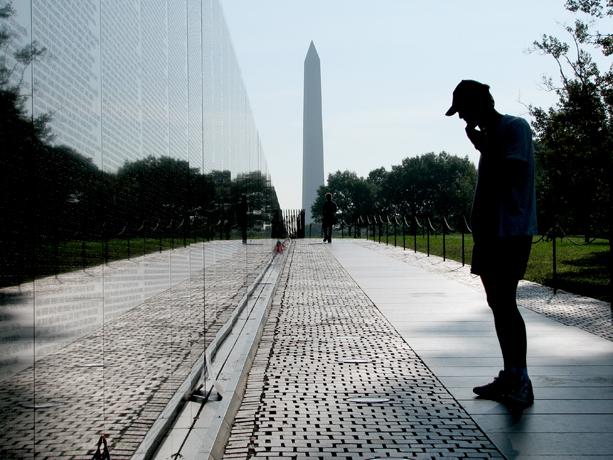In Memoriam: Revisiting the Wall
By • July 16, 2015 0 1496

These balmy days between Memorial Day and the Fourth of July are a good time to visit the war memorials on the National Mall. If you haven’t been to the Vietnam Veterans Memorial lately, go back and take another look. At a time in our history when we can appreciate the ambiguity of military involvement, it is as expressive a war memorial as you will find anywhere.
Four years after the fall of Saigon, a group of Vietnam veterans started a drive to raise funds for a memorial. The plan was initiated by Jan Scruggs, an army corporal during the Vietnam war, who was inspired by the film “The Deer Hunter.” Scruggs wanted to honor his dead comrades in what he described as “the most ambiguous venture in America’s military history.” Though the fund drive started at a time when many Americans wanted to forget this chapter of our history, the group managed to raise $9 million and get Congressional approval to build the memorial.
In 1980, Scruggs and his group asked for design bids. More than 1,400 applications were submitted. The guidelines for the memorial were that it be reflective and contemplative and harmonize with its surroundings; contain the names of the 58,000 Americans who were killed or missing in action; and make no political statement about the war. The entries were given numbers so the judges would not be influenced by the names of the designers.
The unanimous choice was No. 1026, a design submitted by Maya Lin, the 20-year-old daughter of Chinese immigrants and a student at Yale University.
Lin’s black wall was not well received. There was a public uproar about the memorial being disrespectful and inappropriate. Some of the most prominent people in favor of the memorial withdrew their support when they saw the design, including H. Ross Perot and James Webb. The opposition was so great that — as a supposed remedy — a bronze statue of three soldiers was proposed to stand where the two sections of wall come together. Lin was against this plan, and a compromise was reached in which the statue was placed off to one side, as if the soldiers were observing the wall and the visitors. Later, another statue was added nearby to honor the women who had served.
The controversy surrounding the unusual memorial diminished once people began visiting the three-acre plot of ground, where the shining wall reflects the trees and grass as well as the visitors themselves. When you walk along the wall, you see your reflection imposed over the seemingly unending rows of names; you feel that you are no longer on one side of the wall, but a part of it.
The effect is transformative. Empathy for the loss of the 58,000 soldiers is squarely and vividly brought home. Whether you were for or against the war — or any war — and whether or not there is a name of someone you knew there, the words of Hemingway’s famous novel, and John Donne’s poem, come to mind: “Never send to know for whom the bell tolls; it tolls for thee.”
When Lin originally submitted the design, in response to an assignment at Yale, she received the grade of B. Now the Vietnam Veterans Memorial is ranked 10th on the American Institute of Architects’ “List of America’s Famous Architecture.” It attracts more than three million visitors a year. When she won the award, the young artist explained that the design was a symbol of regeneration. “Take a knife and cut open the earth,” she said, “and with time the grass will heal it.”
Take another look at this very moving memorial the next time you have some free time on a summer afternoon.
Donna Evers is the owner and broker of Evers & Co. Real Estate, the largest womanowned and woman-run real estate firm in the metropolitan area; the proprietor of Twin Oaks Tavern Winery in Bluemont, Virginia, and a devoted fan of Washington-area history. Reach her at devers@eversco.com.

